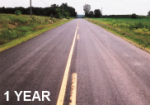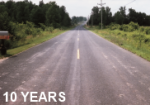Why use Slurry Surfacing?
Because pavements begin deteriorating immediately after they are constructed, the question for most owners is what to do about their pavements once they are built so they get the most out of their initial investment. It may be human nature for many of us to put off maintaining our car, our house, and even our health until these things break down and need fixing. However, this approach eventually leads to more serious problems that are time-consuming and expensive to solve. This same concept applies to streets and roads.
 |
 |
 |
 |
 |
Studies all across the country have documented that preventive maintenance (i.e., the timely application of surface treatments such as slurry surfacing) will extend the life of pavements while providing increased safety and improved driving conditions in far less time and at much less cost than worst-first treatments. It has been proven that the most cost-effective strategy is to perform preventive maintenance activities like slurry surfacing on the better-rated pavements first before poorer-rated pavements are repaired. Pavement preservation pays off in both the short and long term. Experience shows that spending a dollar on pavement maintenance methods can eliminate or delay spending $6 to $10 in future rehabilitation or reconstruction costs. Your doctor knows it is less expensive to keep you healthy than to help you regain your health after it is lost. Preventive maintenance to pavements applies the same principal as regular doctor visits, changing a car’s oil, or reshingling a roof.
At a time when transportation budgets are competing for every dollar available, preventive maintenance is an essential tool for extending the life of a pavement. When it comes to preventive maintenance, it is our hope that you consider slurry surfacing. Slurry surfacing corrects small problems before they become big problems, saves money, reduces delays, and improves safety and rideability.
Reasons for slurry surfacing
• seals minor surface cracks
• stops pavement deterioration
• results in highly cost effective surface
• provides a water-resistant seal
• reduces noise from vehicle traffic
• fills ruts and results in minor leveling
• prevents further oxidation
• used in place of thicker overlays
• improves road profile
• stops raveling of pavement surface
• creates a textured finish with excellent skid resistance
• eliminates bleeding or tacky pavement surfaces
• restores loss of fines at pavement surface